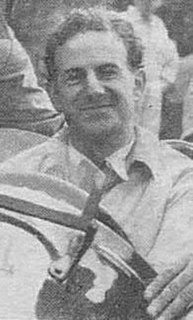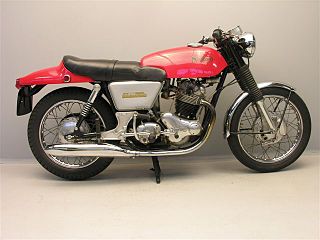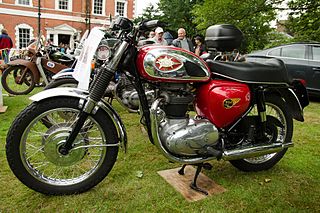Related Research Articles

The Norton Motorcycle Company is a brand of motorcycles, originally based in Birmingham, England. This company is owned by Indian multinational giant TVS Motor Company. For some years around 1990, the rights to use the name on motorcycles was owned by North American financiers. From 2008 to 2020, a line of motorcycles was produced under owner and chief executive Stuart Garner. Due to financial failure with large debts, in April 2020 administrators BDO agreed to sell certain aspects of Garner's business to Project 303 Bidco Limited, a new business established for the purpose with links to Indian motorcycle producer TVS Motor Company.

A. J. Stevens & Co. Ltd was a British automobile and motorcycle manufacturer in operation from 1909 to 1931. The company was founded by Joe Stevens in Wolverhampton, England. After the firm was sold, the name continued to be used by Matchless, Associated Motorcycles and Norton-Villiers on four-stroke motorcycles till 1969, and since the name's resale in 1974, on lightweight, two-stroke scramblers and today on small-capacity roadsters and cruisers. The company held 117 motorcycle world records.

Roger Dennistoun "Dennis" Poore was a British entrepreneur, financier and sometime racing driver. He became chairman of NVT during the dying days of the old British motorcycle industry.

Matchless is one of the oldest marques of British motorcycles, manufactured in Plumstead, London, between 1899 and 1966. A wide range of models were produced under the Matchless name, ranging from small two-strokes to 750 cc four-stroke twins. Matchless had a long history of racing success; a Matchless ridden by Charlie Collier won the first single-cylinder race in the first Isle of Man TT in 1907.

Geoff Monty was an English professional motorcycle racer, constructor, rider-sponsor and retail dealer, initially based in Kingston on Thames and later – under the name Monty and Ward – Twickenham areas, near London, with a move to Edenbridge, Kent by 1968.

Associated Motor Cycles (AMC) was a British motorcycle manufacturer founded by the Collier brothers as a parent company for the Matchless and AJS motorcycle companies. It later absorbed Francis-Barnett, James, and Norton before incorporation into Norton-Villiers. Henry Herbert Collier founded Matchless as a cycle company in 1878. His sons Henry (Harry) and Charles (Charlie) joined him and the name was changed to H. Collier & Sons.
Norton Villiers Triumph (NVT) was a British motorcycle manufacturer, formed by the British government to continue the UK motorcycling industry, until the company's ultimate demise.

The Norton Commando is a British Norton-Villiers motorcycle with an OHV pre-unit parallel-twin engine, produced by the Norton Motorcycle company from 1967 until 1977. Initially having a nominal 750 cc displacement, actually 745 cc (45.5 cu in), in 1973 it became an 850 cc, actually 828 cc (50.5 cu in). It had a hemi-type head, similar to all OHV Norton engines since the early 1920s.

Peter Williams was a British former professional motorcycle racer. He competed in Grand Prix motorcycle road racing from 1966 to 1973. He also competed at many levels on home short-circuit races. He raced many times on the Isle of Man TT course from 1966 to 1973. His father was Jack Williams who ran the Associated Motor Cycles (AMC) race department. Williams trained in mechanical engineering and introduced via racing alloy wheels, an innovation which is commonplace on today's road bikes, and was also an early pioneer of solo-motorcycle disc brakes.

The Matchless G50 is an historic racing British motorcycle made by Associated Motorcycles (AMC) at the former Matchless works in Plumstead, London. Developed in 1958 from the 350 cc AJS 7R, but with the engine capacity increased to 500 cc, 180 G50s were built in the next four years. Although less powerful than its main competitor the Norton Manx the G50 proved highly competitive at three hundred pounds and was faster round bends. If success is measured by longevity then this is the most successful Matchless motorcycle, and high specification replicas are still being produced to this day, although financial problems at AMC ended production in 1963.

The Matchless G12 is a British motorcycle made by Associated Motorcycles at the former Matchless works in Plumstead, London. Developed in 1958 specifically to capture the potentially lucrative US market, the last G12 was produced in 1966.

The Norton Atlas was a Norton motorcycle made between 1962 and 1968, until it was replaced by the Norton Commando.

The Norton P11 was a 745 cc (45.5 cu in) air-cooled OHV parallel twin motorcycle made by Norton-Villiers from 1967 to 1969. Designed as an extremely light high power-to-weight ratio desert racer, P11 was revised in 1968 to the P11A and marketed as the Norton Ranger, a road legal version of the P11 with a more comfortable seat to make it suitable for normal road use. The Norton P11 gained a reputation as a 'desert racer' in the late 1960s but by 1969 lighter two stroke desert racers began to dominate the sport and the Norton had begun Commando production and it was selling well. Norton ended production of the P11 series to concentrate on the Commando, which used a number of ideas developed on the P11 series.

The isolastic frame, designated by Norton as GlideRide, used a system of engine-to-frame mountings incorporating rubber bushes to isolate the vibration of the vertical twin engine from the frame and rider. The isolastic frame was developed for use with the Commando inclined engine, whilst the Featherbed frame continued in production for the Mercury with a softer-specification 650 cc vertical-engine until 1970.
Colin Jordan Seeley was a British motorcycle retailer who later became a motorcycle sidecar racer, motorcycle designer, constructor and retailer of accessories. In 1992 he was involved in running the Norton Rotary race team.

BSA motorcycles were made by the Birmingham Small Arms Company Limited (BSA), which was a major British industrial combine, a group of businesses manufacturing military and sporting firearms; bicycles; motorcycles; cars; buses and bodies; steel; iron castings; hand, power, and machine tools; coal cleaning and handling plants; sintered metals; and hard chrome process.

The BSA unit twins were a range of unit construction twin-cylinder motorcycles made by the Birmingham Small Arms Company (BSA) and aimed at the US market. A range of 500 cc (31 cu in), 650 cc (40 cu in) and 750 cc (46 cu in) twins were produced between 1962 and 1972, but they were really developments of the older pre-unit A7/A10 model range with less weight. The engines had a reputation for vibration, but acceleration was good for the time, to a top speed of 100 miles per hour (160 km/h).

The Norton Commando Production Racer was a hand built production racer produced by Norton-Villiers from 1970 - 1972. It was based on the road-going Norton Commando, and although fitted with lights it was never intended as a road bike. The model was commonly known as the Yellow Peril.

The Norton Interpol was a police motorcycle produced by the British manufacturer Norton between 1969 and 1976. The Interpol was based on the company's Commando model. The 'Interpol' name was retained for Norton's later Norton Interpol 2 rotary engined police motorcycle.
References
- ↑ Bob Currie, Classic Bikers Club, Retrieved 2013-03-01
- ↑ Gus Kuhn Racing, Retrieved 2013-03-01
- ↑ Bacon, Roy (1987). Norton Twin Restoration. London: Osprey. p. 11. ISBN 0-85045-708-4.
- 1 2 Heathwood, Andrew (1 March 2018). "A summary of data and information on Norton Commando main bearings" (PDF). Norton Owners Club.